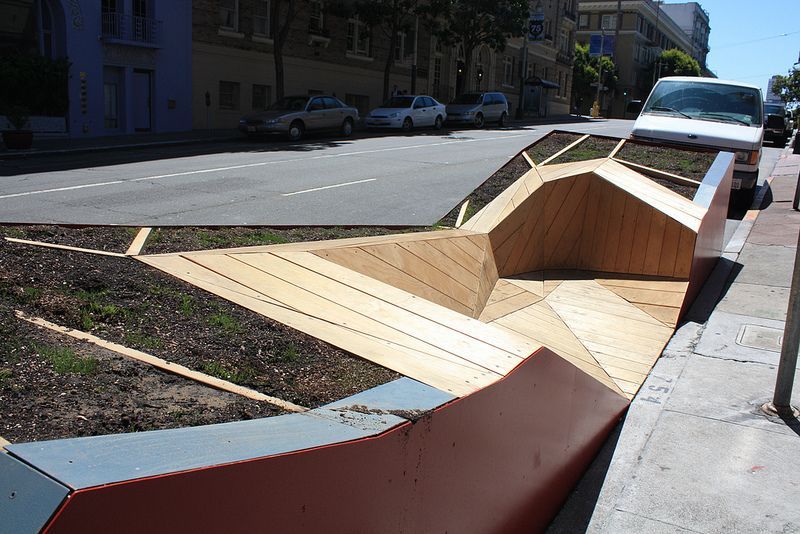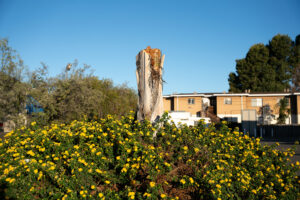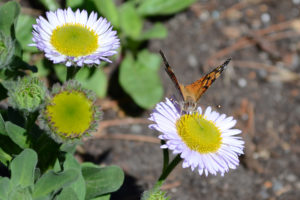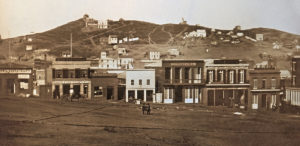Patches of grass aren’t the first (or even the tenth) thing you expect to find in downtown San Francisco. However, with the surge of “parklets” in urban hubs across the Bay Area, open space is being reclaimed for the enjoyment of the public.
What is a parklet? In its simplest form, it is a parking space reclaimed by local business owners, residents, or community organizations, and turned into an area for everyone to use and enjoy. From there, possibilities for design are limitless. Many of the parks feature public art, bicycle parking, greenery, and seating — all creatively put together in a space only about 34 by 6 feet.
Beginning with Rebar group’s original parklet model in 2005, the movement to install mini public parks has spread rapidly across the country and around the world. That first parklet at 1st and Mission in San Francisco was only a two hour experiment, which involved a patch of grass, a bench, and a tree situated between two parking meters.
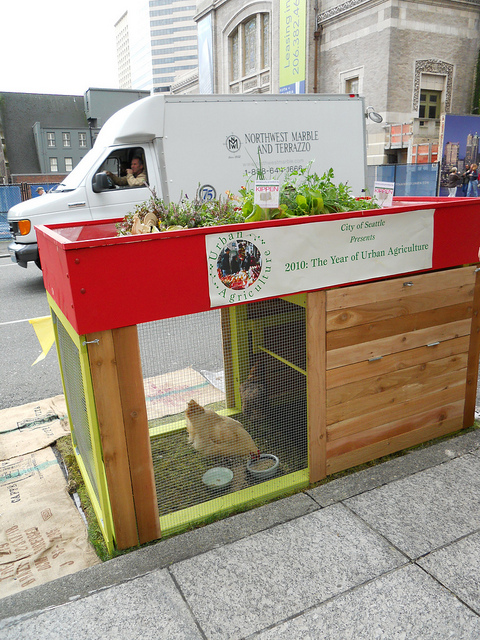
When the meter ran out, the park was packed up, but the parklet movement was just getting started. The experiment inspired Park(ing) Day, celebrated annually on the third Friday of September, during which people “feed the meter” and take over parking spaces all over the world to use them as public space. Since the first Park(ing) Day in 2006, when only 13 cities were involved, the event has exploded, spanning six continents and 35 countries in 2011, with nearly 1000 mini parks set up for the day.
This year’s PARKing Day will take place on September 20th. Groups all over the Bay Area will be building parks.
From these temporary spaces, the idea for permanent parklets was born. According to Pavement to Parks, the organization which facilitates the parklet building process, “parklets are intended as aesthetic enhancements to the streetscape, providing an economical solution to the need for increased public open space.”
Pavement to Parks is also working on a number of plazas across the city with a similar mission in mind. In places like the the intersection of Castro and Market Streets, the road has been closed off in favor of seating and greenery to open up the space to the public.
“The space is really valuable for so many other things than cars,” said Robin Abad Ocubillo of Pavement to Parks.
“The point of Pavement to Parks Plazas is to experiment and test. It is a way to show that the negative consequences aren’t as acute as people fear them to be.”
Despite the loss of vehicular traffic, the plazas have attracted all kinds of pedestrian activity, with the artful design and a number of community events ranging from children’s bicycling classes to Christmas tree farms.
In San Francisco alone, there are nearly 40 permanent parklets, with many more under construction or in the application process, along with five pilot plazas. Pavement to Parks is set to publish a global parklet map on their website in the coming months. Oakland currently has four parklet locations, and a large public plaza similar to those in San Francisco was recently opened on August 16th right in the junction of Telegraph and Broadway.
In Berkeley, a three year pilot program for parklets was approved in July, and city officials are hoping to see success similar to those in San Francisco and Oakland.
“This is going to be a win-win for our community,” said Berkeley City Councilman Jesse Arreguìn.
The pilot program, modeled largely after San Francisco’s program, will allow the temporary installation of up to ten different parklets around the city.
Arreguìn is especially enthusiastic about the program because Berkeley has frequently been cited as one of the most dangerous cities in California for pedestrians and bicyclists. To Arreguìn, crowded areas like the popular restaurant Cheeseboard Pizza on the corner of Shattuck and Vine where customers frequently resort to sitting in the median of the roadway “clearly illustrate the demand for more public space.” Similar high-traffic areas like Telegraph north of Dwight Way are also on the city’s radar as places in dire need of expanded public space. Arreguìn is hopeful that the first proposals for parklets will be submitted and approved by the end of the year.
“I see no reason why [the parklets] won’t be successful,” he said.
Want to see what the hype is all about for yourself? Nearly all parklets feature some kind of plant life, but here’s a few that really caught our eye with exceptional greenery!
Deepistan National Parklet, 937 Valencia St., San Francisco:
The first residential parklet, this whimsical space features all kinds of exotic looking plant life, including a miniature triceratops (in plant form, of course).

Mojo Bicycle Shop Cafe, 639 A Divisadero, San Francisco:
When seated at the tables in this parklet, the tall plants lining the planters around the perimeter of this parklet create a visual barrier between the parklet and the street, secluding the mini-park from the urban hustle and bustle.

farm:table, 754 Post St., San Francisco:
In a combination of modern and natural design, this parklet features angular seating and patches of grass and succulents to liven up the sidewalk.
